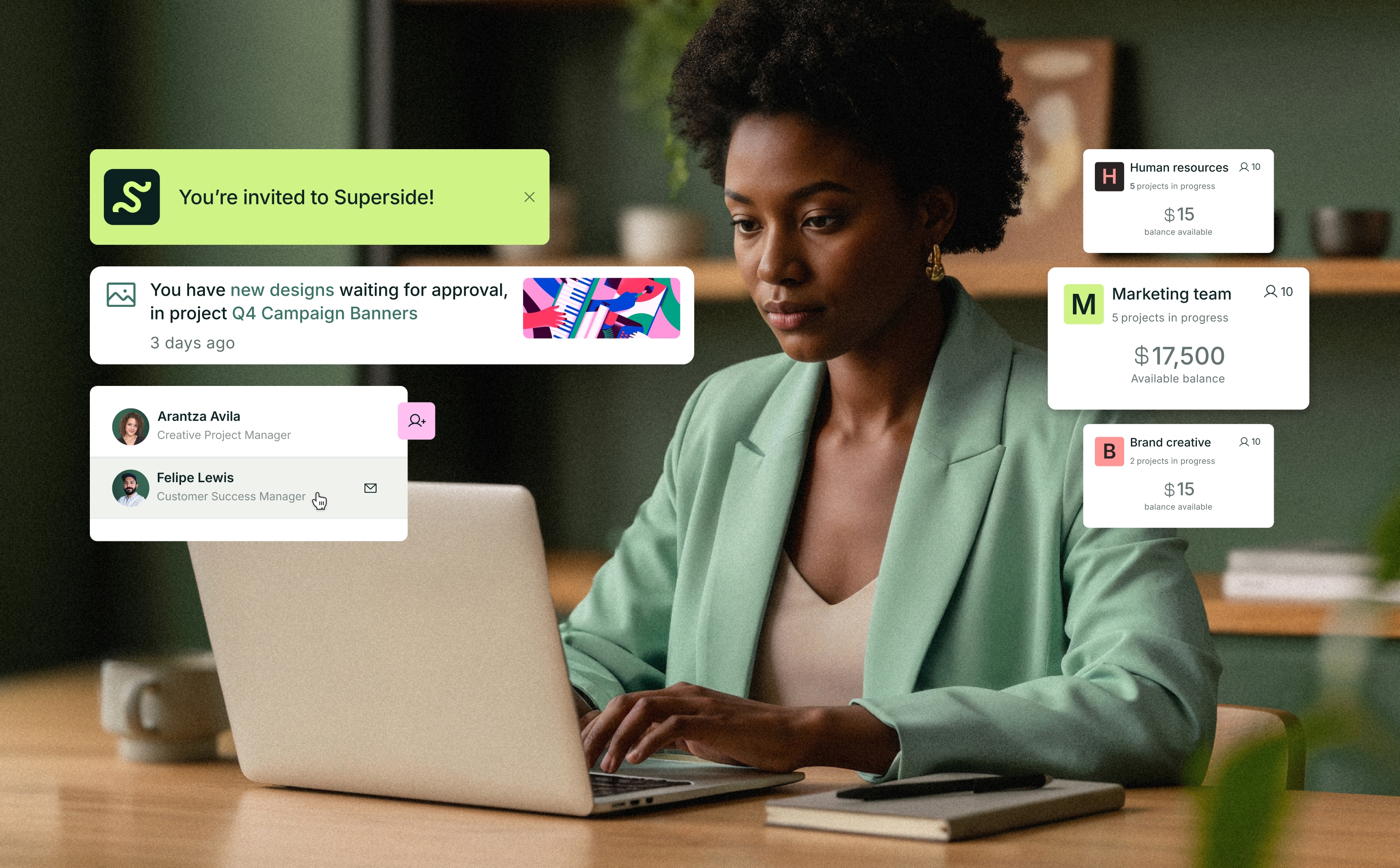
There’s a special frustration that comes from a good idea gone unheard. It’s painful enough when no one shares your sentiment about ordering a pizza, but it weighs heavier when you’ve got something big on your mind that no one takes seriously. You exclaim at the elephant in the room, only to have everyone insist it’s part of the furnishing.
In marketing, leadership buy-in is where many good ideas fall off. Decision-makers have reasons to be averse, of course… it’s hard to want to try new things in a shaky market. They want stability, but can’t afford to increase spending dramatically. They want solutions that deliver concrete results, but are wary of anything that could be labeled an “experiment”. Leaders want safe, smart bets. And when they don’t see the evidence, they’re out.
While you may be at your wit’s end cooking up ways to ask for the resources your team needs, there are ways to increase your chances of getting what you want from leaders. To learn how to frame your goals as their goals is to have the keys to the kingdom.
Below, we’ll show you how to get what you need from senior leadership by speaking their language.
We'll discuss how to:
Show Your Needs as Their Opportunity
1. Show Your Needs as Their Opportunity
Let’s use creative resourcing as an example, and walk through how you can sell your story to decision-makers. Say you’re on the marketing or design team, and don’t often have the creative each initiative/asset needs in a timely, reliable fashion. Branding is everything to your team, but you don’t have capacity.
You need more creative resources, and you need execs to see it as a necessity.
Marketing’s successful campaign is just as important as sales’ new accounts, but both wins need to be put into context for each individual or department.
Consider your specific executive audience before putting your case together: Are you aiming this at a creative director, or a marketing leader? Both? Who you’re talking to should determine how you talk, and may even necessitate breaking said presentation up by segments.
Ask “why”.
Using the example above: Why do you care about getting the appropriate creative resources? Well, aside from risking burnout on each team, insufficient support from creative means poorer marketing performance. Leading with design is a tactic that the biggest names in commerce have been honing for decades—nearly centuries, in some cases. In a market now almost completely reliant on visual media, a steady supply of strong creative is needed for marketing and design teams to meet their targets.
Your “why” may be reaching your lead targets, driving engagement; proving the right people are interacting with your brand in the right way. Having the right creative at the ready is how you move the needle on these goals. No successful campaign or branding effort can exist without it, and in your current state, you don’t have it.
Lead with their needs, not yours.
In the business world, people rarely get what they need simply because they need it.
Why does a marketing or design leader care about your specific request? Well, they’re being squeezed to perform by the CEO in the same way they may be squeezing you. They’re looking at the big picture (setting overarching marketing or creative strategy, doing competitive research, bartering for marketing dollars etc.), and can’t always see the fine print.
Be their magnifying glass, and show them the direct connection between creative resourcing and big picture marketing outcomes. If they’re all about brand ubiquity, there’s no room for overflowing pipelines on the design team. Draw a direct line between leaders’ goals and your needs.
Highlight the wins, warn of the risks.
What happens when design and marketing get the support they need? Here are a few parallels our imagined marketer or creative can draw for senior leadership:
- The creative is fresher, meaning stronger ad performance.
- Design’s pipeline is clearer, meaning they have the capacity to innovate, research and experiment with ideas that distinguish the brand.
- Assets and campaigns get to market faster, making the brand more competitive and consistent.
- Every marketing effort requiring supporting creative (nearly all of them these days) is elevated, while never increasing headcount.
These are just a few of the proof points our hero’s execs like to hear��—with the emphasis on “proof”. Driving this home may require a little digging into your own team’s performance, proving the value of consistent creative to meeting and exceeding key targets. It may even be useful to highlight instances of insufficient and/or ineffective creative yielding lower results, or having hindered a campaign in some way.
There are risks associated with your unfulfilled need, and they deserve airtime as well. Burnout is the silent killer of many strong marketing and design teams, and failing to fit either team with the necessary tools puts them on a downward trajectory.
Use the available data to make some predictions about opportunities that may be lost if the team can’t move on this.
2. Give Them Options
While you may favor a certain solution to your problem, don’t try to back leaders into a corner. The answer may seem obvious to you, but people aren’t apt to see things your way if you pose an ultimatum.
Even if it really is the only option, shying away from discomfort is a frustrating niggle in human psychology that you’ll have to work around.
Work multiple angles.
Say our marketer/creative is leaning towards support from a dedicated design team to supplement existing creative. To them, it’s the perfect way to nail the “wins” in the bullets above. Still, it shows prudence to outline other ways you might have the need fulfilled.
For one, you might consider adding a designer, or training more marketers to use design tools, or expediting the creative process for maximum output. None of these propositions are without fault—they leave some glaring gaps you’ll have to address when you make your case to them. Adding one head is costly and may not even cover the need; creative made by marketers is at risk of underperforming; rushing in-house design hurts the final product, etc.
It’s reasonable to have an ideal solution, but showing leaders you’ve studied the problem from multiple angles reduces the guesswork on their end. Do diligence by illustrating each option’s benefits and drawbacks.
3. Show Them the Data
When it’s time to talk to decision-makers, there can be no discussion without data. Make no mistake, there’s a ton of evidence for creative resourcing as the catalyst for growth, all of which our marketer/creative can use. But what scale looks like for your team may be unique to your industry or company, and may require a personalized touch.
Diving into the data can be dirty work, but it’s rewarding in how it supports your points. It’s another voice in the room, and it’s backing you up. Gain or use your access to key team metrics and start cross-referencing. In our example, a marketer might dig up historical data on which creative assets have performed well, exploring why they might have performed well.
Draw conclusions based on what you know about producing effective marketing assets: The bandwidth that fresh creative demands; the connection between the time put into an asset and the results it yields; the capacity for just-in-time creative to bolster marketing efforts. Use the available data to tell a story/stories about how fitting your team with the resources it needs has delivered results in the past.
This will require more than one example, of course. But once you see the pattern—and you probably will see a pattern—the story starts to tell itself. From there, it’s just a matter of grabbing the right screenshots, charts and numbers and popping them into whichever presentation medium you choose. Be sure to keep the story succinct to maintain engagement. All they need is a snapshot.
Win Buy-In with a Smart Bet
Contrary to popular belief, a little bit of experimentation in times of strain can be helpful. Just ask your creative team: When nothing seems to be working, changing things up even 20% can reignite the spark. The willingness to approach the problem from a different angle opens up all new possibilities, and gets the project to the finish line with surprising results.
Getting senior leaders to see your side of things is an exercise in translation, and in doing at least a bit of digging. Showing your problems to be their problems, and your solutions their solutions is how you close the chasm between your good idea and their hangups. Your elephant isn’t an “elephant”—it’s their opportunity. It’s the smart bet they should be making in uncertain times.
In a digital era, high-caliber creative is what moves the needle on marketing initiatives. Solutions that prioritize consistent, brand-aligned creative are smart bets. Leaning on dedicated design to cover the multitude of marketing needs is a safe play: It keeps market-ready material flowing without adding as much as a new head. Without exploding the budget in the short term, it lays the groundwork for long term payoff. It’s exactly what executives want to see.












